Nanocomposites Produced with the Addition of Carbon Nanotubes Dispersed on the Surface of Cement Particles Using Different Non-Aqueous Media
Abstract
:1. Introduction
2. Materials and Methods
2.1. CNT Dispersion on the Surface of Anhydrous Cement Particles in Non-Aqueous Suspensions
2.2. Preparation of Specimens
2.3. Fresh Properties of Cement Paste
2.4. Evaluation of Electrical-Volumetric Conductivity
- ρ = electrical resistivity (Ω × m);
- R = electrical resistance (Ω);
- I = current (A);
- V = potential difference (V);
- L = length of the specimen (m);
- S = cross sectional area (m²).
2.5. Axial Compression
2.6. Tensile Analysis by Diametrical Compression of Cement Pastes
- σT = splitting tensile strength (MPa);
- Fmax = maximum load (N);
- l = length of the specimen (mm);
- d = diameter (mm).
2.7. Helium Pycnometry
2.8. Statistical Analysis of Results
3. Results and Discussion
3.1. Consistency and Setting Time
3.2. Evaluation of Electrical-Volumetric Conductivity
3.3. Compressive Strength
3.4. Analysis of the Splitting Tensile Strength
3.5. Helium Pycnometry
4. Conclusions
- Acetone, isopropanol, and ethanol have proven efficient in the dispersion of CNTs in amounts up to 0.10% by weight of cement, considering the enhancement in the mechanical properties of reinforced cement pastes. This result strengthens the hypothesis that the CNTs are well bonded to the hydration products and behave as bridges in the pores [8], allowing a mechanism of CNT-matrix load transfer [40], contributing to the increase in the mechanical properties and durability due to the control of cracking propagation;
- CNTs slightly affect the workability and delay the setting time under fresh conditions. Besides that, hydrated cement paste reinforced with CNTs is denser. These findings suggest an influence of the CNTs addition in cement hydration kinetics, implying porosity reduction that leads to improvements in mechanical properties;
- Both compressive and splitting tensile tests recorded higher strengths in the presence of 0.05% of CNTs, suggesting an optimal range for the incorporation of CNTs in all three media analyzed. As an exception, acetone media did not record mechanical improvements in the presence of CNTs in the splitting tensile test, whereas isopropanol media recorded the most expressive gains in both the compressive and splitting tensile tests;
- The results of electrical resistivity are less expressive when compared to the mechanical properties tests. Cement pastes with dispersion environments of isopropanol and ethanol showed increased electrical resistivity. The inverse correlation proposed by Ma et al. (2018) [11], in which the higher mechanical properties are associated with a lower electrical resistivity, and vice versa, was not observed in this study, possibly due to the fact that the concentrations of CNTs (less than 2%) did not contribute to the increase in electrical conductivity [35];
- A significant reduction in electrical resistivity was observed for the cement paste mixtures dispersed in a non-aqueous environment of acetone. This suggests that acetone might be responsible for the reduced electrical resistivity due to the interaction between the functional groups and the cement matrix. However, for a better understanding of the influence of the dispersion of the cement particles in a non-aqueous environment of acetone in the electrical resistivity of the cement composite, further and more specific studies are suggested;
- It is suggested that the presence of CNTs might have acted as nucleator of hydration for the nanostructured cement pastes dispersed in isopropanol, since the higher hydration of the cement paste, the higher the electrical resistivity [39]. This behavior can also be related to the porosity reduction recorded by helium pycnometry, causing the conductivity through C-S-H gel and contributing to the increase in electrical resistivity [37].
- The evaluation of the chemical interaction between the cement matrix and the acetone functional groups (-COOH and -OH), investigating the possibility of the ion exchange reaction [13] and electrical conductivity for cement compositions reinforced with CNTs;
- Further microstructural investigation involving pore distribution in cement paste with the addition of CNTs, in order to assess the influence of CNTs on pore refinement to support helium pycnometry results;
- The evaluation of CNTs performance as nucleators of cement hydration products by cement paste composition analysis.
Author Contributions
Funding
Data Availability Statement
Acknowledgments
Conflicts of Interest
References
- Makar, J.M.; Beaudoin, J.J. Carbon nanotubes and their application in the construction industry. In Proceedings of the 1st International Symposium on Nanotechnology in Construction, National Research Council Canada, Ottawa, ON, Canada, 23–25 June 2003; Volume 331, p. 341. [Google Scholar]
- Kamedulski, P.; Lukaszewicz, J.P.; Witczak, L.; Szroeder, P.; Ziolkowski, P. The importance of structural factors for the electrochemical performance of graphene/carbon nanotube/melamine powders towards the catalytic activity of oxygen reduction reaction. Materials 2021, 14, 2448. [Google Scholar] [CrossRef] [PubMed]
- Shoukat, R.; Khan, M.I. Carbon nanotubes: A review on properties, synthesis methods and applications in micro and nanotechnology. Microsyst. Technol. 2021, 27, 4183–4192. [Google Scholar] [CrossRef]
- Han, M.; Muhammad, Y.; Wei, Y.; Zhu, Z.; Huang, J.; Li, J. A review on the development and application of graphene based materials for the fabrication of modified asphalt and cement. Constr. Build. Mater. 2021, 285, 122885. [Google Scholar] [CrossRef]
- Collins, F.; Lambert, J.; Duan, W.H. The influences of admixtures on the dispersion, workability, and strength of carbon nanotube–OPC paste mixtures. Cem. Concr. Compos. 2012, 34, 201–207. [Google Scholar] [CrossRef]
- Ahmed, H.; Bogas, J.A.; Guedes, M.; Pereira, M.F.C. Dispersion and reinforcement efficiency of carbon nanotubes in cementitious composites. Mag. Concr. Res. 2019, 71, 408–423. [Google Scholar] [CrossRef]
- Al-Rub, R.K.A.; Ashour, A.I.; Tyson, B.M. On the aspect ratio effect of multi-walled carbon nanotube reinforcements on the mechanical properties of cementitious nanocomposites. Constr. Build. Mater. 2012, 35, 647–655. [Google Scholar] [CrossRef]
- Zou, B.; Chen, S.J.; Korayem, A.H.; Collins, F.; Wang, C.M.; Duan, W.H. Effect of ultrasonication energy on engineering properties of carbon nanotube reinforced cement pastes. Carbon N. Y. 2015, 85, 212–220. [Google Scholar] [CrossRef]
- Wang, B.; Han, Y.; Liu, S. Effect of highly dispersed carbon nanotubes on the flexural toughness of cement-based composites. Constr. Build. Mater. 2013, 46, 8–12. [Google Scholar] [CrossRef]
- Hu, Y.; Luo, D.; Li, P.; Li, Q.; Sun, G. Fracture toughness enhancement of cement paste with multi-walled carbon nanotubes. Constr. Build. Mater. 2014, 70, 332–338. [Google Scholar] [CrossRef]
- Ma, S.; Qian, Y.; Kawashima, S. Performance-based study on the rheological and hardened properties of blended cement mortars incorporating palygorskite clays and carbon nanotubes. Constr. Build. Mater. 2018, 171, 663–671. [Google Scholar] [CrossRef]
- Gurumurthy, G.; Hunashyal, A.M.; Quadri, S.S.; Banapurmath, N.R.; Shetter, A.S.; Hiremath, R.K.; Hallad, S.A. Effect of multiwalled carbon nanotubes and nano aluminium oxide on flexural and compressive strength of cement composites. Int. J. Adv. Res. Sci. Eng. 2014, 3, 215–223. [Google Scholar]
- Nasibulina, L.I.; Anoshkin, I.V.; Nasibulin, A.G.; Cwirzen, A.; Penttala, V.; Kauppinen, E.I. Effect of carbon nanotube aqueous dispersion quality on mechanical properties of cement composite. J. Nanomater. 2012, 2012, 169262. [Google Scholar] [CrossRef] [Green Version]
- Musso, S.; Tulliani, J.-M.; Ferro, G.; Tagliaferro, A. Influence of carbon nanotubes structure on the mechanical behavior of cement composites. Compos. Sci. Technol. 2009, 69, 1985–1990. [Google Scholar] [CrossRef]
- Hunashyal, A.M.; Tippa, S.V.; Quadri, S.S.; Banapurmath, N.R. Experimental investigation on effect of carbon nanotubes and carbon fibres on the behavior of plain cement mortar composite round bars under direct tension. Int. Sch. Res. Not. 2011, 2011, 856849. [Google Scholar] [CrossRef] [Green Version]
- Kordkheili, H.Y.; Hiziroglu, S.; Farsi, M. Some of the physical and mechanical properties of cement composites manufactured from carbon nanotubes and bagasse fiber. Mater. Des. 2012, 33, 395–398. [Google Scholar] [CrossRef]
- Kordkheili, H.Y.; Shehni, S.E.; Niyatzade, G. Effect of carbon nanotube on physical and mechanical properties of natural fiber/glass fiber/cement composites. J. For. Res. 2015, 26, 247–251. [Google Scholar] [CrossRef]
- Rocha, V.V.; Ludvig, P. Preparação e caracterização de nanocompósitos com nanotubos de carbono dispersos em surfactantes. J. Eng. Exact Sci. 2017, 3, 1097–1105. [Google Scholar] [CrossRef] [Green Version]
- Zhang, Z.; Scherer, G.W. Supercritical drying of cementitious materials. Cem. Concr. Res. 2017, 99, 137–154. [Google Scholar] [CrossRef] [Green Version]
- Sanchez, F. Carbon nanofibre/cement composites: Challenges and promises as structural materials. Int. J. Mater. Struct. Integr. 2009, 3, 217–226. [Google Scholar] [CrossRef]
- Makar, J.; Margeson, J.; Luh, J. Carbon nanotube/cement composites-early results and potential applications. In Proceedings of the 3rd International Conference on Construction Materials: Performance, Innovations and Structural Implications, Nagoya, Japan, 24–26 August 2005. [Google Scholar]
- Makar, J.M.; Chan, G.W. Growth of cement hydration products on single-walled carbon nanotubes. J. Am. Ceram. Soc. 2009, 92, 1303–1310. [Google Scholar] [CrossRef] [Green Version]
- Alsharef, J.M.A.; Taha, M.R.; Khan, T.A. Physical dispersion of nanocarbons in composites—A review. J. Teknol. 2017, 79, 69–81. [Google Scholar] [CrossRef] [Green Version]
- Nasti, G.; Gentile, G.; Cerruti, P.; Carfagna, C.; Ambrogi, V. Double percolation of multiwalled carbon nanotubes in polystyrene/polylactic acid blends. Polymer 2016, 99, 193–203. [Google Scholar] [CrossRef]
- Danoglidis, P.A.; Konsta-Gdoutos, M.S.; Gdoutos, E.E.; Shah, S.P. Strength, energy absorption capability and self-sensing properties of multifunctional carbon nanotube reinforced mortars. Constr. Build. Mater. 2016, 120, 265–274. [Google Scholar] [CrossRef]
- Kim, G.M.; Yoon, H.N.; Lee, H.K. Autogenous shrinkage and electrical characteristics of cement pastes and mortars with carbon nanotube and carbon fiber. Constr. Build. Mater. 2018, 177, 428–435. [Google Scholar] [CrossRef]
- Coelho, I. Estudo das Propriedades Piezoresistivas de Compósitos Preparados com Pré-Dispersão de Nanotubos de Carbono em Partículas de Cimento. MSc Thesis, Centro Federal de Educação Tecnológica de Minas Gerais (CEFET-MG), Belo Horizonte, Brazil, 2021. [Google Scholar]
- ASTM C305-20; Standard Practice for Mechanical Mixing of Hydraulic Cement Pastes and Mortars of Plastic Consistency. Annual Book of ASTM Standards. American Society for Testing and Materials (ASTM): West Conshohocken, PA, USA, 1995; pp. 188–190.
- American Society for Testing and Materials (ASTM). Standard test method for normal consistency of hydraulic cement. In Annual Book of ASTM Standards; American Society for Testing and Materials (ASTM): West Conshohocken, PA, USA, 2004. [Google Scholar]
- ASTM C191-19; Test Methods for Time of Setting of Hydraulic Cement by Vicat Needle. C01 Committee: Seattle, WA, USA, 2006.
- da Silva Neto, G.A. Influência de Diferentes Agregados Miúdos Reciclados nas Propriedades de Microconcretos com Relação água/Cimento e Trabalhabilidade Estabelecidas com Auxílio de Aditivo Superplastificante. MSc Thesis, Universidade Federal de Minas Gerais, Belo Horizonte, Brazil, 2019. [Google Scholar]
- ABNT NBR 9204; Concreto Endurecido—Determinação da Resistividade Elétrico-Volumétrica - Método de Ensaio. Associação Brasileira de Normas Técnicas: São Paulo, Brazil, 2012.
- ABNT NBR 7222; Concreto e Argamassa—Determinação da Resistência à Tração Por Compressão Diametral de Corpos de Prova Cilíndricos. Associação Brasileira de Normas Técnicas: São Paulo, Brazil, 2011.
- Souza, T.C.; Suzuki, S.; Ludvig, P.; Calixto, J.M.; Ladeira, L.O. Nanotubos de carbono: Um caminho para a sustentabilidade de materiais cimentícios. Concreto e Construções 2015, 1, 20–24. [Google Scholar]
- Jiang, S.; Shan, B.; Ouyang, J.; Zhang, W.; Yu, X.; Li, P.; Han, B. Rheological properties of cementitious composites with nano/fiber fillers. Constr. Build. Mater. 2018, 158, 786–800. [Google Scholar] [CrossRef]
- de Assis Soares, P. Caracterização da Reologia no Estado Fresco de Pastas de Cimento Portland Fabricadas com Nanotubos de Carbono Sintetizados Diretamente Sobre o Clínquer. MSc Thesis, Universidade Federal de Minas Gerais, Belo Horizonte, Brazil, 2019. [Google Scholar]
- Hansson, I.L.H.; Hansson, C.M. Electrical resistivity measurements of Portland cement based materials. Cem. Concr. Res. 1983, 13, 675–683. [Google Scholar] [CrossRef]
- Baggio, T.; Billig, J.D.; Korzenowski, C.; da Graça Sebag, M.; Silva Filho, L.C.P. Investigação das Propriedades Elétricas de Compostos Cimentícios Dopados com Nanotubos de Carbono (NTC). In Proceedings of the 57° Congresso Brasileito do Concreto CBC, Bonito, Brazil, 27–30 October 2015. [Google Scholar]
- Helene, P.R.L. Contribuição ao estudo da corrosão em armaduras de concreto armado. São Paulo 1993, 231, 14. [Google Scholar]
- Xu, S.; Liu, J.; Li, Q. Mechanical properties and microstructure of multi-walled carbon nanotube-reinforced cement paste. Constr. Build. Mater. 2015, 76, 16–23. [Google Scholar] [CrossRef]
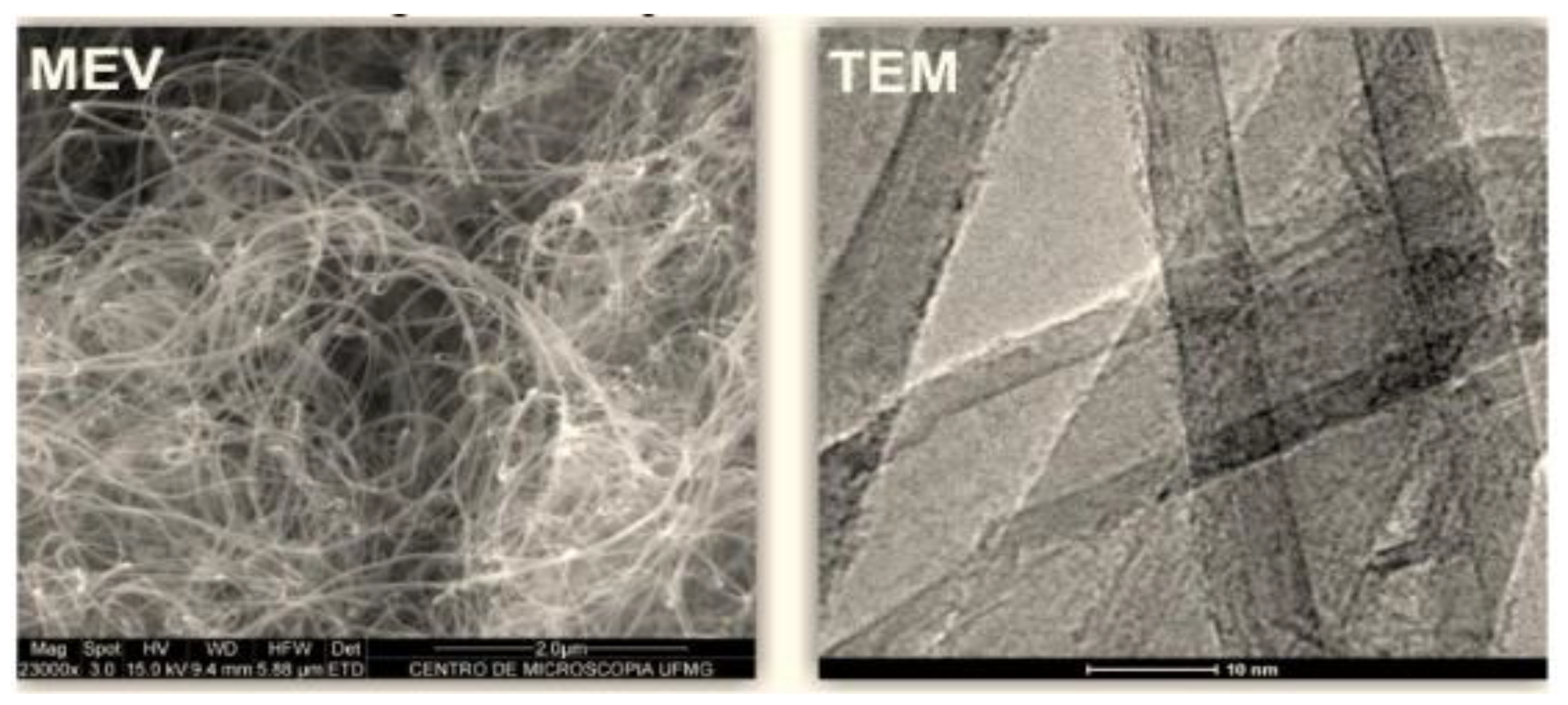
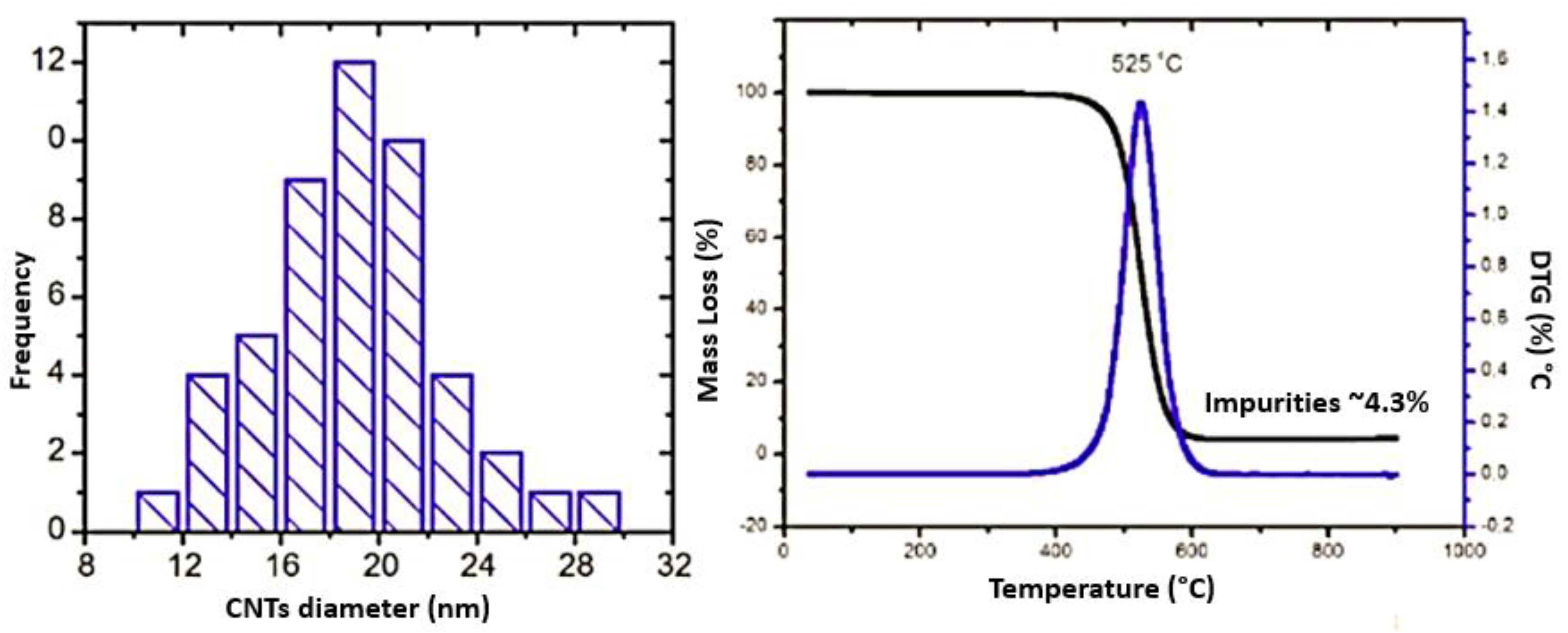
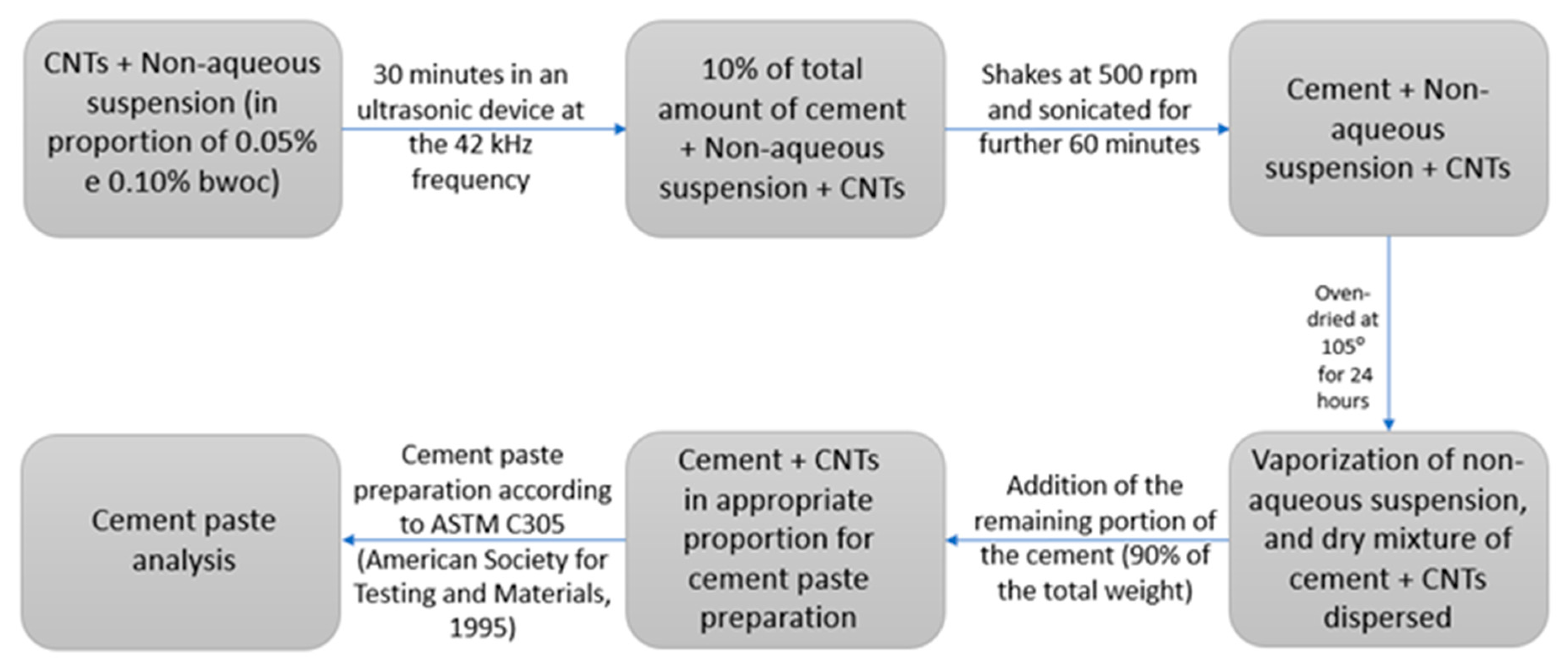

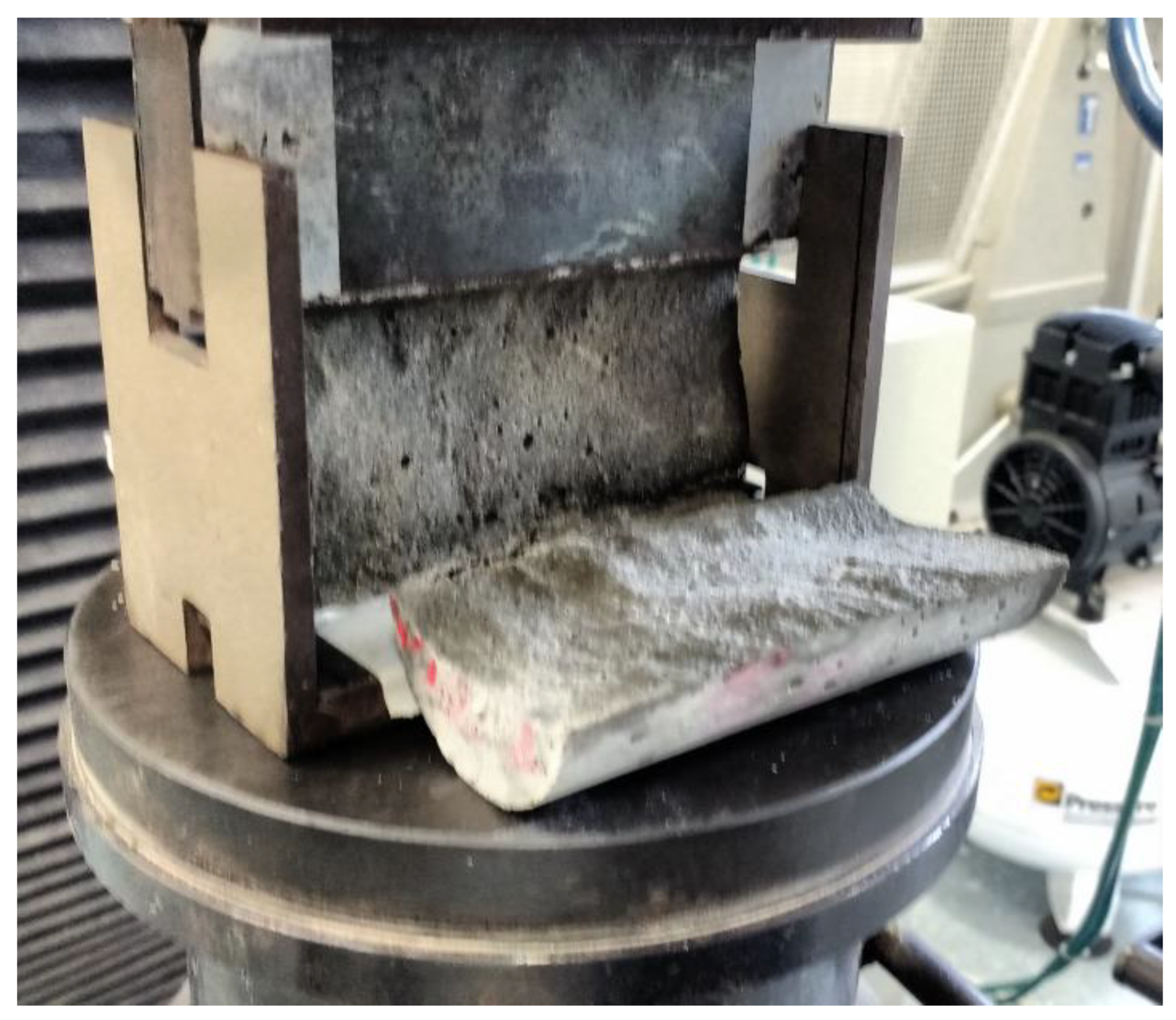
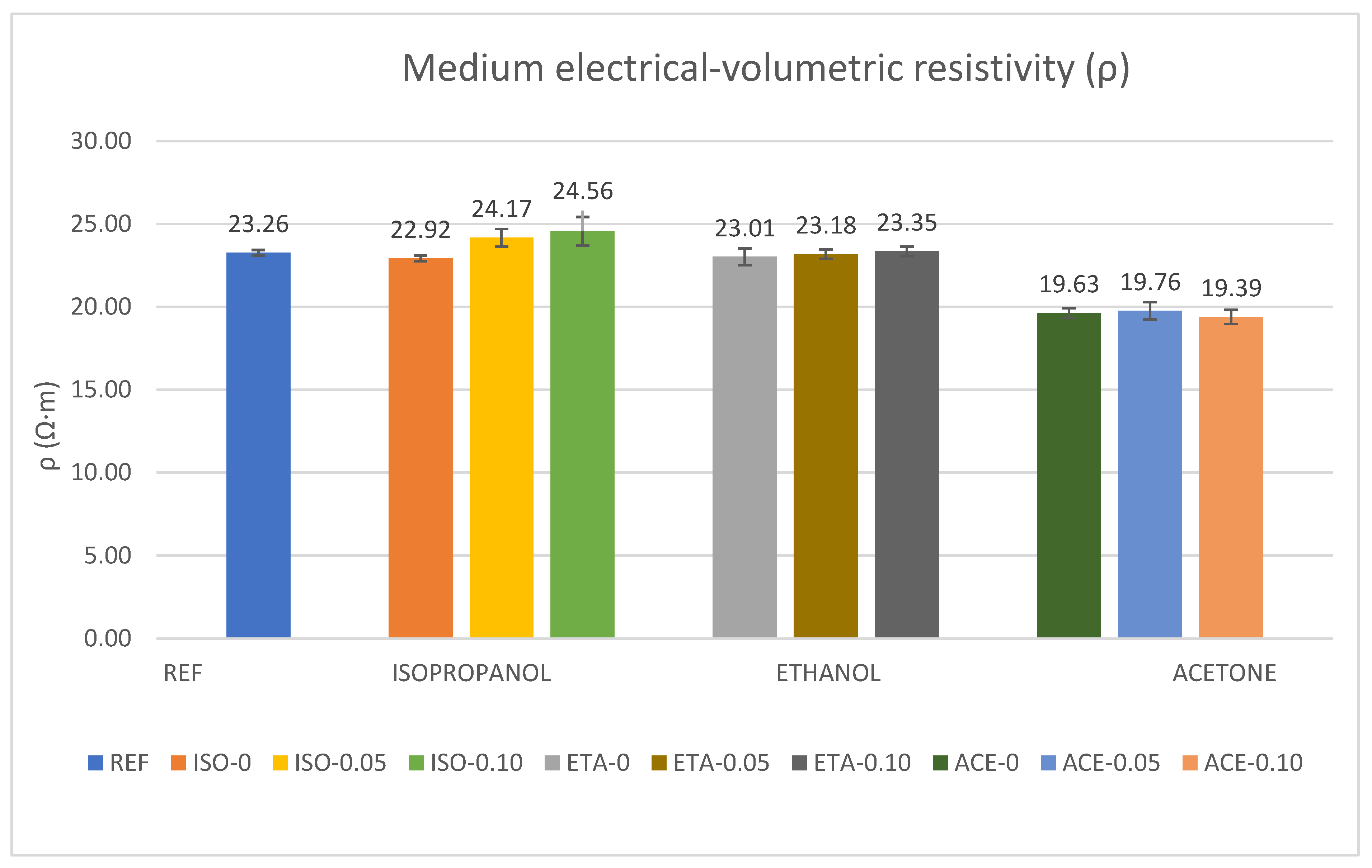
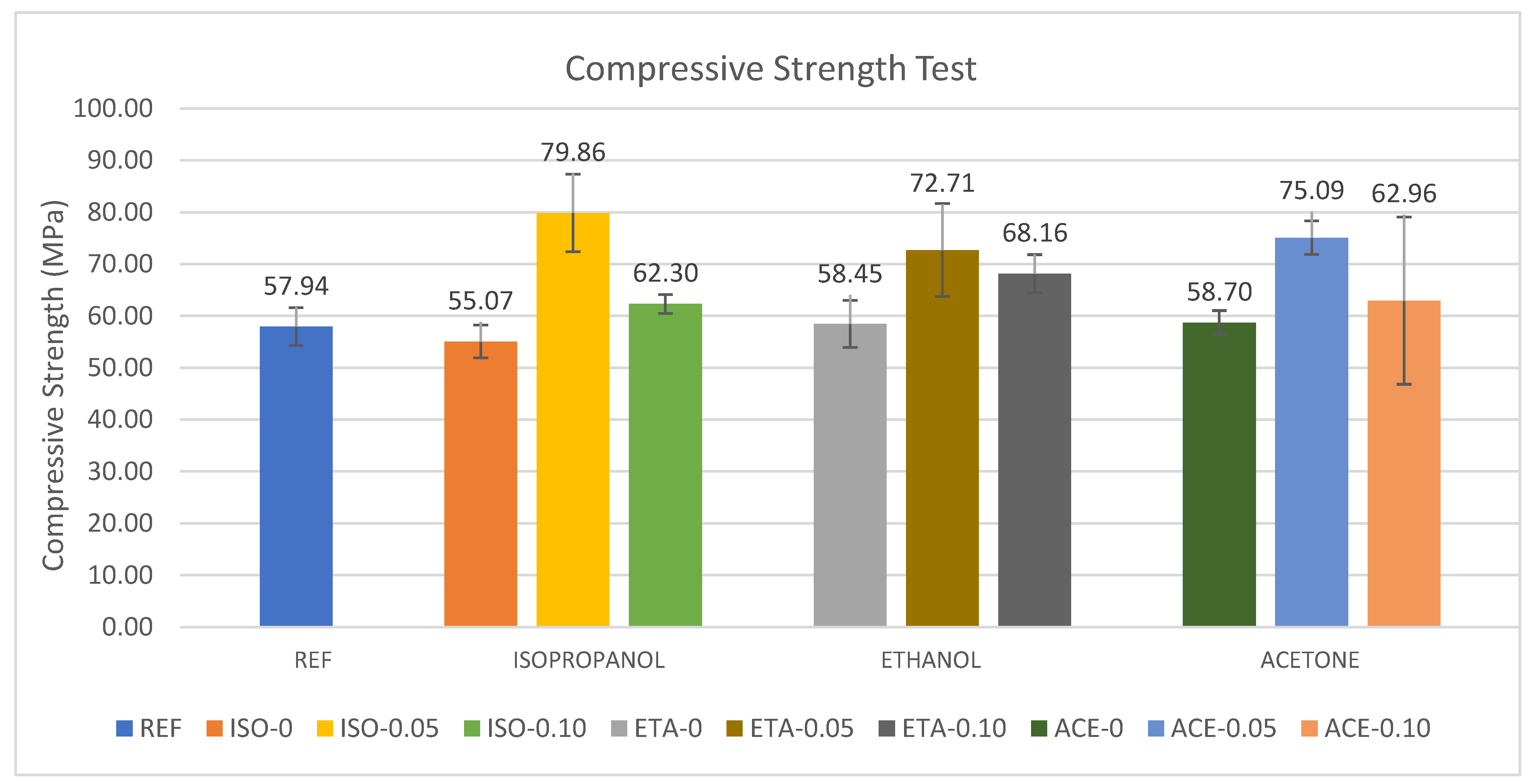
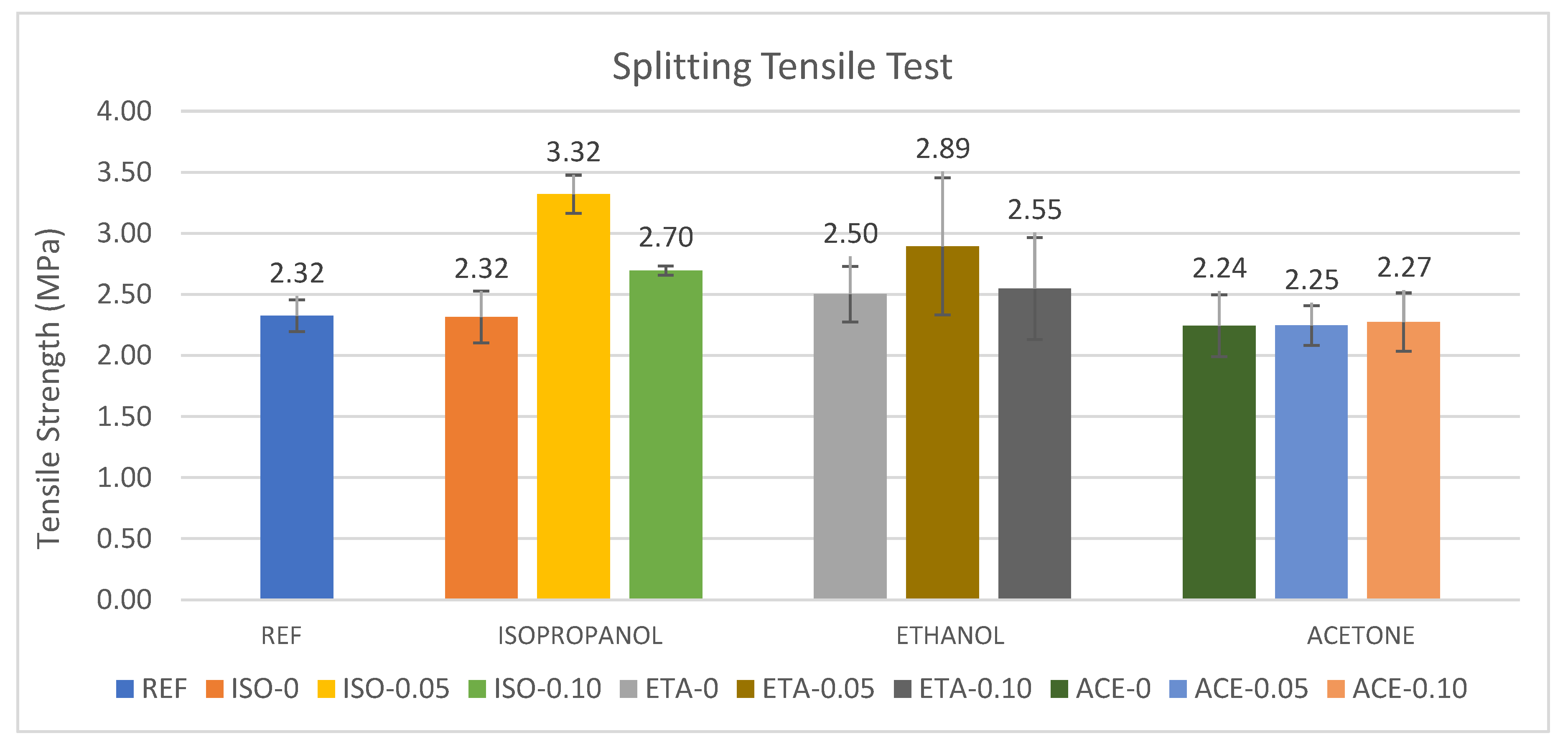
| Mixture | Description and CNTs Content | Non-Aqueous Media |
|---|---|---|
| REF | Cement paste without CNTs and without sonication process. | - |
| ISO-0 | Cement paste without CNTs and with cement dispersed in a non-aqueous environment. | Isopropanol |
| ACE-0 | Acetone | |
| ETA-0 | Ethanol | |
| ISO-0.05 | Cement paste with addition of 0.05% of CNTs and with the dispersion process in a non-aqueous environment. | Isopropanol |
| ACE-0.05 | Acetone | |
| ETA-0.05 | Ethanol | |
| ISO-0.10 | Cement paste with addition of 0.10% of CNTs and with the dispersion process in a non-aqueous environment. | Isopropanol |
| ACE-0.10 | Acetone | |
| ETA-0.10 | Ethanol |
| Isopropanol | Ethanol | Acetone | ||||||||
|---|---|---|---|---|---|---|---|---|---|---|
| REF | ISO-0 | ISO-0.05 | ISO-0.10 | ETA-0 | ETA-0.05 | ETA-0.10 | ACE-0 | ACE-0.05 | ACE-0.10 | |
| Start of Setting (Hours: Minutes) | 01:40 | 01:42 | 01:56 | 01:54 | 01:52 | 01:56 | 01:58 | 01:27 | 02:27 | 02:03 |
| End of Setting (Hours: Minutes) | 02:20 | 02:22 | 02:52 | 02:41 | 02:30 | 02:41 | 02:38 | 01:57 | 03:17 | 02:38 |
| Setting Time (Hours: Minutes) | 00:40 | 00:40 | 00:56 | 00:47 | 00:38 | 00:45 | 00:40 | 00:30 | 00:50 | 00:35 |
| Consistency (mm) | 17 | 17 | 15 | 14 | 16 | 16 | 14 | 17 | 17 | 15 |
| Mean Resistivity ρ (Ω·m) | Standard Deviation | Coefficient of Variation (%) | Variation of Resistivity (REF) | Variation of Resistivity (Same Environment) | |
|---|---|---|---|---|---|
| REF | 23.261 | 0.172 | 0.74% | - | - |
| ISO-0 | 22.921 | 0.167 | 0.73% | −1.46% | - |
| ISO-0.05 | 24.165 | 0.526 | 2.18% | +3.89% | +5.43% |
| ISO-0.10 | 24.561 | 0.859 | 3.50% | +5.59% | +7.16% |
| ETA-0 | 23.015 | 0.504 | 2.19% | −1.06% | - |
| ETA-0.05 | 23.177 | 0.282 | 1.22% | −0.36% | +0.71% |
| ETA-0.10 | 23.349 | 0.290 | 1.24% | +0.38% | +1.45% |
| ACE-0 | 19.630 | 0.297 | 1.51% | −15.61% | - |
| ACE-0.05 | 19.762 | 0.527 | 2.66% | −15.04% | +0.68% |
| ACE-0.10 | 19.392 | 0.425 | 2.19% | −16.63% | −1.21% |
| Mean Compressive Strength (MPa) | Standard Deviation (MPa) | Coefficient of Variation (%) | Variation of Compressive Strength (REF) | Variation of Compressive Strength (Same Dispersion Environment) | |
|---|---|---|---|---|---|
| REF | 57.94 | 3.632 | 6% | - | - |
| ISO-0 | 55.07 | 3.190 | 6% | −4.95% | - |
| ISO-0.05 | 79.86 | 7.478 | 9% | 37.82% | 45.00% |
| ISO-0.10 | 62.30 | 1.843 | 3% | 7.52% | 13.12% |
| ETA-0 | 58.70 | 2.337 | 4% | 1.30% | - |
| ETA-0.05 | 75.09 | 3.241 | 4% | 29.59% | 27.92% |
| ETA-0.10 | 62.96 | 16.128 | 26% | 8.65% | 7.25% |
| ACE-0 | 58.45 | 4.530 | 8% | 0.88% | - |
| ACE-0.05 | 72.71 | 8.964 | 12% | 25.49% | 24.40% |
| ACE-0.10 | 68.16 | 3.651 | 5% | 17.63% | 16.61% |
| Mean Splitting Tensile Strength (MPa) | Standard Deviation (MPa) | Coefficient of Variation (%) | Variation of Compressive Strength (REF) | Variation of Compressive Strength (Same Dispersion Environment) | |
|---|---|---|---|---|---|
| REF | 2.32 | 0.130 | 6% | - | - |
| ISO-0 | 2.32 | 0.212 | 9% | −0.39% | - |
| ISO-0.05 | 3.32 | 0.157 | 5% | 42.79% | 43.35% |
| ISO-0.10 | 2.70 | 0.037 | 1% | 15.93% | 16.39% |
| ETA-0 | 2.24 | 0.254 | 11% | −3.49% | - |
| ETA-0.05 | 2.25 | 0.163 | 7% | −3.42% | 0.07% |
| ETA-0.10 | 2.27 | 0.239 | 11% | −2.22% | 1.32% |
| ACE-0 | 2.50 | 0.228 | 9% | 7.62% | - |
| ACE-0.05 | 2.89 | 0.562 | 19% | 24.48% | 15.67% |
| ACE-0.10 | 2.55 | 0.417 | 16% | 9.55% | 1.80% |
| Isopropanol | Ethanol | Acetone | |||||||
|---|---|---|---|---|---|---|---|---|---|
| REF | ISO-0 | ISO-0.05 | ISO-0.10 | ETA-0 | ETA-0.05 | ETA-0.10 | ACE-0 | ACE-0.05 | ACE-0.10 |
| 2.379 | 2.372 | 2.384 | 2.393 | 2.377 | 2.388 | 2.391 | 2.375 | 2.385 | 2.384 |
Disclaimer/Publisher’s Note: The statements, opinions and data contained in all publications are solely those of the individual author(s) and contributor(s) and not of MDPI and/or the editor(s). MDPI and/or the editor(s) disclaim responsibility for any injury to people or property resulting from any ideas, methods, instructions or products referred to in the content. |
© 2023 by the authors. Licensee MDPI, Basel, Switzerland. This article is an open access article distributed under the terms and conditions of the Creative Commons Attribution (CC BY) license (https://creativecommons.org/licenses/by/4.0/).
Share and Cite
Rocha, V.V.; Bacelar, B.A.; Coelho, I.D.; Ludvig, P. Nanocomposites Produced with the Addition of Carbon Nanotubes Dispersed on the Surface of Cement Particles Using Different Non-Aqueous Media. C 2023, 9, 36. https://doi.org/10.3390/c9010036
Rocha VV, Bacelar BA, Coelho ID, Ludvig P. Nanocomposites Produced with the Addition of Carbon Nanotubes Dispersed on the Surface of Cement Particles Using Different Non-Aqueous Media. C. 2023; 9(1):36. https://doi.org/10.3390/c9010036
Chicago/Turabian StyleRocha, Vanessa Vilela, Bruno Athaíde Bacelar, Isabela Domingues Coelho, and Péter Ludvig. 2023. "Nanocomposites Produced with the Addition of Carbon Nanotubes Dispersed on the Surface of Cement Particles Using Different Non-Aqueous Media" C 9, no. 1: 36. https://doi.org/10.3390/c9010036
APA StyleRocha, V. V., Bacelar, B. A., Coelho, I. D., & Ludvig, P. (2023). Nanocomposites Produced with the Addition of Carbon Nanotubes Dispersed on the Surface of Cement Particles Using Different Non-Aqueous Media. C, 9(1), 36. https://doi.org/10.3390/c9010036





